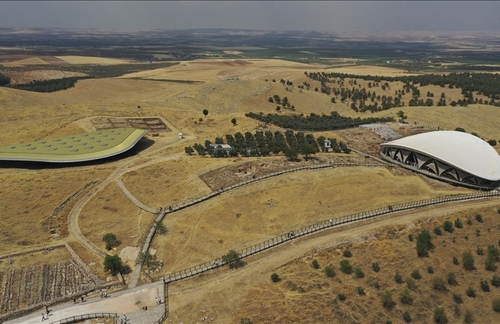Photo: AA
As dig teams have unearthed grinding stones at the famed ancient site of Göbeklitepe in southeastern Türkiye, new findings are expected to shed light on the history of humanity.
“During this year’s work we made a large number of findings such as grinding stones and hammerstones indicating daily use in these places,” Necmi Karul, an archeologist at İstanbul University and leader of the dig team, told Anadolu Agency (AA).
Ancient grinding stones were often used to crush or pulp plants or animals for cooking.
“Analysis of these findings will give us an idea of what these activities were,” he said, adding that they plan to do this during the winter.
Karul said that while some of the generally accepted views on Göbeklitepe are still valid, some are likely incorrect in light of new findings from excavations.
As the team began to consider other possibilities about the ancient site, he said, “One of the prominent ones is that although it has been suggested that there were only public buildings in Göbeklitepe, called temples by some, it was known that there were places in the form of dwellings and shelters.”
He went on to say, “More of these (dwellings and shelters) have been found. So this has fueled debate over whether this was a gathering center or a settlement where people live at the same time.”
Karul said that the fact that the team found residences in Karahantepe and other stone hills which existed around the same time as Göbeklitepe increased the probability that these places were settlements containing public buildings.
Focus on conservation
However, he said the excavation team has been focusing more on conservation efforts in recent years due to an influx of visitors to the ancient site after UNESCO named it a World Heritage site.
The team is currently working with the German Archaeological Institute to ensure that the structures and the figures on them are not damaged, according to Karul.
Göbeklitepe and other sites under the name of Tas Tepeler (Stone Hills) were contemporary to each other and covered a period of some 1,500 years, he said, stressing that all the findings from these sites reflects the culture of that period.
He added that according to those findings, the first agricultural experiments were carried out in this region.
“The existence of tools pointing to agricultural experiments shows us that when the first settlements began to appear at the site, there was no agricultural activity, but wild grains were collected, and that this collection process evolved into the cultivation of plants over time,” Karul added.
While the layers at nearby Çakmaktepe are “possibly older” than Göbeklitepe and Karahantepe, architectural remains pointing to the presence of complex societies in Sayburc from the beginning of the Neolithic period were unearthed last year, Karul said.
The team also found the remains of a rectangular-planned building from the end of Neolithic period, which would demonstrate a complex character at the Sefertepe site, adding that findings from the pre-Neolithic period were also unearthed in the Sogut field.
“It is a fact that both Göbeklitepe and other settlements are sites that were part of an interacting social organization in a wide region about 11,000-11,500 years ago.”
“The excavation work continues in nine different locations this year as part of the project Tas Tepeler,” Karul said, noting the project under the auspices of the Culture and Tourism Ministry started last year.
The excavations are being carried out simultaneously by multinational teams at the sites, he added.
“Construction of a new society”
While Karul described the period as the beginning of settled life and living together in larger groups for the first time, he stressed that this brought a new social order, new relationships, and a division of labor.
On the presence of a developed workforce organization, Karul said that public buildings are among the best indicators of this and that the figures in these structures and the scenes depicted on the figures are the products of a communal memory based on a distant past.
“When we put all this together, we see the construction of a new society that we have never encountered before.”
As the World Neolithic Congress is set to be held in Sanliurfa, southeastern Türkiye next September, he said, “The archaeological knowledge here will be shared with colleagues and it will be an opportunity for us to learn from the experts of the Neolithic period that there are different neolithic eras from around the world.” (VK)
Source:Bianet



